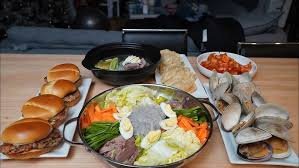
north korean food
What Is North Korean Cuisine?
North Korean food is one of the most mysterious and least explored cuisines in the world. Due to the country’s isolation, much of what we know about North Korean culinary culture comes from defectors, journalists, and rare glimpses into daily life through documentaries and state media. While often compared to South Korean cuisine, North Korean food is distinct in terms of ingredients, cooking techniques, and cultural significance.
Rooted in simplicity, survival, and tradition, North Korean dishes reflect the harsh climate, limited resources, and long-standing traditions of the Korean Peninsula. Despite these limitations, the cuisine offers surprising variety, deep flavor, and cultural depth.
For more context on the cultural divide, check out this guide comparing North and South Korean food.
The Key Characteristics of North Korean Food
Though there are regional variations, North Korean food generally shares several core traits:
- Less spicy and less oily than South Korean cuisine
- Heavy reliance on fermented and preserved foods
- Focus on seasonal vegetables, rice, and corn-based dishes
- Minimal use of imported or luxury ingredients
- Emphasis on community eating and modest portions
Despite its simplicity, the food is crafted with care. Meals often include a main dish, several banchan (side dishes), and fermented staples like kimchi or soybean paste.
Staple Ingredients in North Korean Cooking
Most dishes use local and accessible ingredients, particularly those that can be grown or produced in a self-reliant way. Key ingredients include:
- Napa cabbage and radish (for making kimchi)
- Corn and barley (as rice substitutes)
- Soybeans (used in paste, tofu, and sauces)
- Sweet potato noodles (used in cold dishes)
- Pickled vegetables
- Dried fish
- Chilies and garlic (used sparingly)
The lack of imported ingredients means that many North Korean meals are plant-forward, with occasional use of fish, eggs, or meat—usually reserved for special occasions.
You can explore a comparison of Korean staple ingredients here.
Most Popular North Korean Dishes
Let’s dive into some of the most iconic and unique dishes from North Korea.
1. Naengmyeon (냉면) – Cold Buckwheat Noodles
Originating from Pyongyang, naengmyeon is perhaps the most internationally known North Korean dish.
Key Features:
- Served cold in a beef or dongchimi (radish water kimchi) broth
- Made with buckwheat or sweet potato noodles
- Topped with sliced beef, pickled radish, and boiled egg
Though popular in the South as well, Pyongyang-style naengmyeon is milder and less spicy than its southern counterpart.
2. Kimchi (김치)
Kimchi is a cornerstone of both North and South Korean cuisine, but in the North, the varieties are less spicy and more salty.
Northern versions may include:
- White kimchi (non-spicy)
- Radish kimchi with ginger and fermented shrimp
- Kimchi made with wild greens
Learn more about types of kimchi and how they vary by region.
3. Bindaetteok (빈대떡) – Mung Bean Pancakes
Common in rural households, bindaetteok is made from ground mung beans, cabbage, and sometimes pork.
Why It’s Popular:
- Inexpensive and nutritious
- Fried until crispy on the outside, soft inside
- Often served during festivals or communal gatherings
Recipe and background on bindaetteok here.
4. Injo Gogi Bap (인조고기밥) – “Artificial Meat Rice”
This dish emerged during famine years and reflects the creativity born from scarcity.
Made From:
- Soybean paste formed into strips to mimic meat
- Served over rice with soy sauce and chili paste
Despite its humble origin, it’s become a staple in canteens and communal eateries.
5. Ojingeo Bokkeum (오징어볶음) – Spicy Stir-fried Squid
While less spicy in the North, this seafood dish is enjoyed along coastal regions.
Ingredients:
- Squid
- Onion, cabbage, and scallions
- A light gochujang (red chili paste) sauce
Here’s a mild version from Korean Bapsang.
6. Tofu Rice (두부밥 – Dubu Bap)
A mix of crumbled tofu, rice, and kimchi, this dish is a cheap protein source used in school meals and prison camps alike.
Street Food and Snacks
Though not as common as in South Korea, North Korea does have a street food scene, especially in Pyongyang and border towns.
- Hotteok: Sweet rice pancakes with brown sugar
- Fried corn cakes
- Steamed buns filled with veggies or sweet bean paste
- Roasted chestnuts and sunflower seeds
Check out photos and reviews of North Korean street foods in this article from NK News.
Eating Habits and Meal Culture
In North Korea, meals are often communal, with everyone sharing from common dishes. Dining customs reflect the country’s socialist values:
- Meals usually consist of rice or corn, a soup, and several side dishes
- Meat is rare, except during holidays like Chuseok or Kim Il-sung’s birthday
- Emphasis on frugality, resourcefulness, and community values
Most people eat at home, while restaurants are primarily reserved for government officials, foreigners, or special events.
The Impact of Food Shortages
North Korea has experienced multiple famines, especially in the 1990s during the “Arduous March”. As a result:
- People developed recipes using tree bark, grass, and wild roots
- Dishes like corn porridge and soybean rations became common
- Many families rely on home gardening and subsistence farming
These struggles have shaped a cuisine that values efficiency, preservation, and improvisation.
You can read more on this history in the World Food Programme’s report.
Regional Food Differences
Despite its small size, regional cuisines within North Korea do vary:
- Pyongyang: Milder, refined dishes like naengmyeon and cold tofu
- Wonsan (coastal): More seafood like squid and seaweed soup
- Hamhung: Spicier cold noodles (though still milder than South Korean versions)
- Border regions: Influence from Chinese and Russian cooking styles
Dining for Special Occasions
North Korean festivals often include rare delicacies such as:
- Braised short ribs
- Fish stews
- Steamed dumplings
- Sweet rice cakes (tteok)
These are shared during:
- Public holidays
- Family weddings
- New Year celebrations
North Korean Food vs South Korean Food: Key Differences
| Category | North Korean Food | South Korean Food |
|---|---|---|
| Spice Level | Mild | Spicy |
| Meat Usage | Limited | Common |
| Oil & Butter | Rare | Often Used |
| Presentation | Simple | Elaborate |
| Ingredients | Seasonal, preserved | Fresh, imported |
Final Thoughts
North Korean cuisine is a story of resilience, tradition, and regional identity. Though shaped by hardship and limited access to resources, it remains rich in cultural value and culinary ingenuity.
From Pyongyang’s cold noodles to humble tofu rice, North Korean food reflects a population that has learned to make the most of what they have—often with delicious results. As access to the region slowly increases, we can hope to learn more about its recipes, eating customs, and culinary history.






